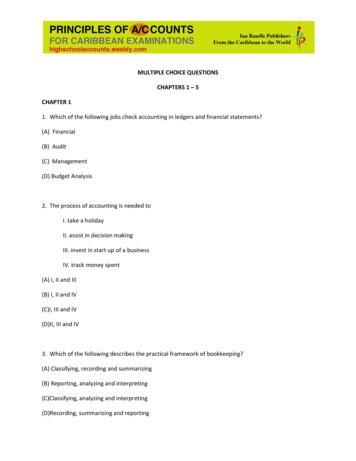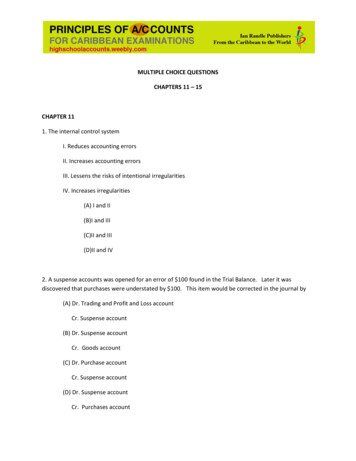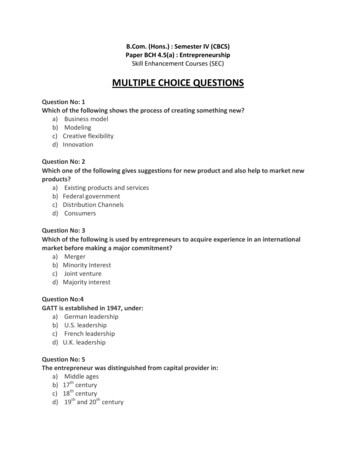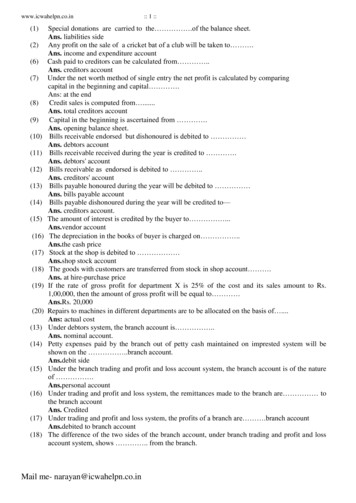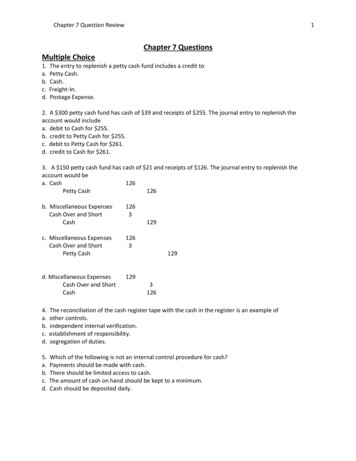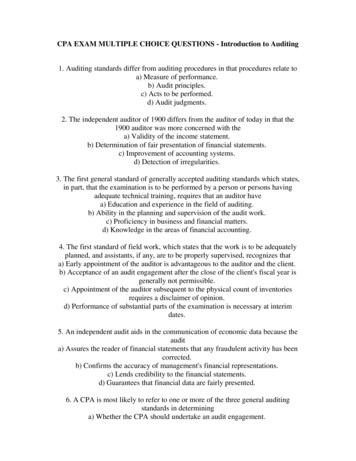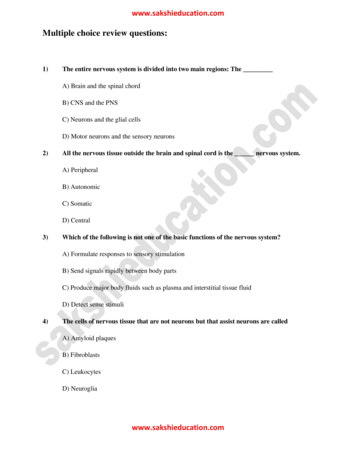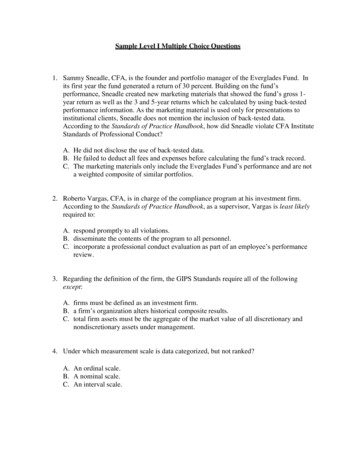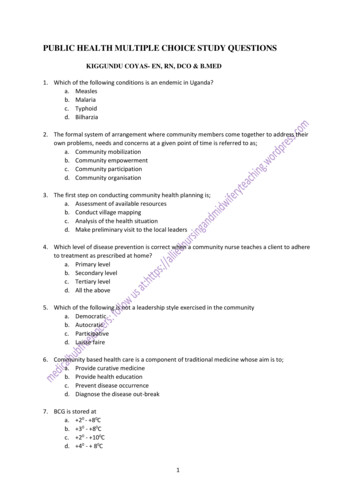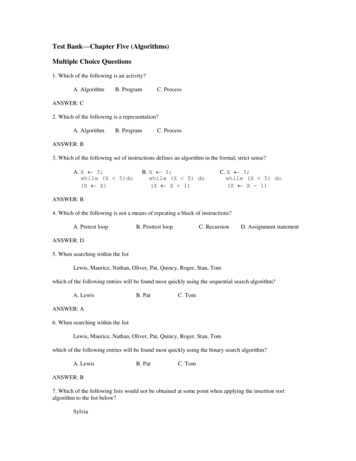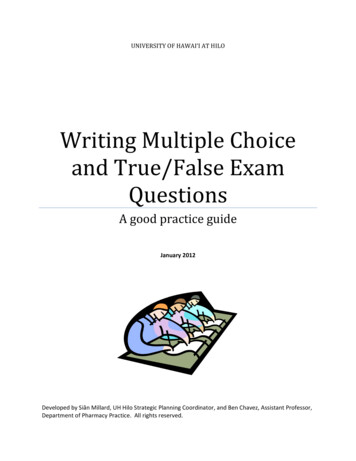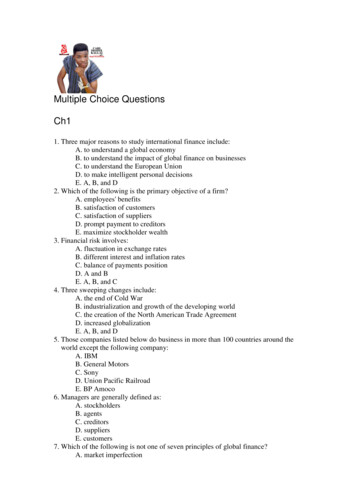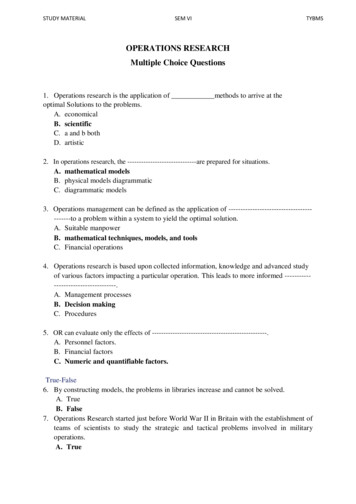
Transcription
STUDY MATERIALSEM VITYBMSOPERATIONS RESEARCHMultiple Choice Questions1. Operations research is the application of methods to arrive at theoptimal Solutions to the problems.A. economicalB. scientificC. a and b bothD. artistic2. In operations research, the ------------------------------are prepared for situations.A. mathematical modelsB. physical models diagrammaticC. diagrammatic models3. Operations management can be defined as the application of -----------------------------------------to a problem within a system to yield the optimal solution.A. Suitable manpowerB. mathematical techniques, models, and toolsC. Financial operations4. Operations research is based upon collected information, knowledge and advanced studyof various factors impacting a particular operation. This leads to more informed ------------------------------------.A. Management processesB. Decision makingC. Procedures5. OR can evaluate only the effects of .A. Personnel factors.B. Financial factorsC. Numeric and quantifiable factors.True-False6. By constructing models, the problems in libraries increase and cannot be solved.A. TrueB. False7. Operations Research started just before World War II in Britain with the establishment ofteams of scientists to study the strategic and tactical problems involved in militaryoperations.A. True
STUDY MATERIALSEM VITYBMSB. False8. OR can be applied only to those aspects of libraries where mathematical models can beprepared.A. TrueB. False9. The main limitation of operations research is that it often ignores the human element inthe production process.A. TrueB. False10. Which of the following is not the phase of OR methodology?A. Formulating a problemB. Constructing a modelC. Establishing controlsD. Controlling the environment11. The objective function and constraints are functions of two types of variables,variables and variables.A. Positive and negativeB. Controllable and uncontrollableC. Strong and weakD. None of the above12. Operations research was known as an ability to win a war without really going in toA. Battle fieldB. FightingC. The opponentD. Both A and B13. Who defined OR as scientific method of providing execuitive departments with aquantitative basis for decisions regarding the operations under their control?A. Morse and Kimball (1946)B. P.M.S. Blackett (1948)C. E.L. Arnoff and M.J. NetzorgD. None of the above14. OR has a characteristics that it is done by a team ofA. ScientistsB. MathematiciansC. AcademicsD. All of the above
STUDY MATERIALSEM VI15. Hungarian Method is used to solveA. A transportation problemB. A travelling salesman problemC. A LP problemD. Both a & b16. A solution can be extracted from a model either byA. Conducting experiments on itB. Mathematical analysisC. Both A and BD. Diversified Techniques17. OR uses models to help the management to determine itsA. PoliciesB. ActionsC. Both A and BD. None of the above18. What have been constructed from OR problems an methods for solving the models thatare available in many cases?A. Scientific ModelsB. AlgorithmsC. Mathematical ModelsD. None of the above19. Which technique is used in finding a solution for optimizing a given objective, such asprofit maximization or cost reduction under certain constraints?A. Quailing TheoryB. Waiting LineC. Both A and BD. Linear Programming20. What enables us to determine the earliest and latest times for each of the events andactivities and thereby helps in the identification of the critical path?A. Programme EvaluationB. Review Technique (PERT)C. Both A and BD. Deployment of resources21. OR techniques help the directing authority in optimum allocation of various limitedresources likeA. Men and MachineB. MoneyTYBMS
STUDY MATERIALSEM VIC. Material and TimeD. All of the above22. The Operations research technique which helps in minimizing total waiting and servicecosts isA. Queuing TheoryB. Decision TheoryC. Both A and BD. None of the aboveUNIT IILINEAR PROGRAMMING PROBLEMS23. What is the objective function in linear programming problems?A. A constraint for available resourceB. An objective for research and development of a companyC. A linear function in an optimization problemD. A set of non-negativity conditions24. Which statement characterizes standard form of a linear programming problem?A. Constraints are given by inequalities of any typeB. Constraints are given by a set of linear equationsC. Constraints are given only by inequalities of typeD. Constraints are given only by inequalities of type25. Feasible solution satisfiesA. Only constraintsB. only non-negative restrictionC. [a] and [b] bothD. [a],[b] and Optimum solution26. In Degenerate solution value of objective function .A. increases infinitelyB. basic variables are nonzeroC. decreases infinitelyD. One or more basic variables are zero27. Minimize Z A. –maximize(Z)B. -maximize(-Z)C. maximize(-Z)D. none of the aboveTYBMS
STUDY MATERIALSEM VI28. In graphical method the restriction on number of constraint is .A. 2B. not more than 3C. 3D. none of the above29. In graphical representation the bounded region is known as region.A. SolutionB. basic solutionC. feasible solutionD. optimal30. Graphical optimal value for Z can be obtained fromA. Corner points of feasible regionB. Both a and cC. corner points of the solution regionD. none of the above31. In LPP the condition to be satisfied isA. Constraints have to be linearB. Objective function has to be linearC. none of the aboveD. both a and bState True or False:32. Objective function in Linear Programming problems has always finite value at theoptimal solution-TRUE33. A finite optimal solution can be not unique- FALSE34. Feasible regions are classified into bounded, unbounded, empty and multiple: TRUE35. Corner points of a feasible region are located at the intersections of the region andcoordinate axes: TRUE36. Identify the type of the feasible region given by the set of inequalitiesx - y 1x - y 2where both x and y are positive.A. A triangleB. A rectangleC. An unbounded regionD. An empty region37. Consider the given vectors: a(2,0), b(0,2), c(1,1), and d(0,3). Which of the followingvectors are linearly independent?TYBMS
STUDY MATERIALA.B.C.D.SEM VITYBMSa, b, and c are independenta, b, and d are independenta and c are independentb and d are independent38. Consider the linear equation2 x1 3 x2 - 4 x3 5 x4 10How many basic and non-basic variables are defined by this equation?A. One variable is basic, three variables are non-basicB. Two variables are basic, two variables are non-basicC. Three variables are basic, one variable is non-basicD. All four variables are basic39. The objective function for a minimization problem is given byz 2 x1 - 5 x2 3 x3The hyperplane for the objective function cuts a bounded feasible region in the space(x1,x2,x3). Find the direction vector d, where a finite optimal solution can be reached.A. d(2,-5,3)B. d(-2,5,-3)C. d(2,5,3)D. d(-2,-5,-3)40. What is the difference between minimal cost network flows and transportation problems?A.B.C.D.The minimal cost network flows are special cases of transportation problemsThe transportation problems are special cases of the minimal cost network flowsThere is no differenceThe transportation problems are formulated in terms of tableaus, while the minimalcost network flows are formulated in terms of graphs41. With the transportation technique, the initial solution can be generated in any fashion onechooses. The only restriction is thatA. the edge constraints for supply and demand are satisfied.B. the solution is not degenerate.C. the solution must be optimal.D. one must use the northwest-corner method.42. The purpose of the stepping-stone method is toB. develop the initial solution to the transportation problem.C. assist one in moving from an initial feasible solution to the optimal solution.D. determine whether a given solution is feasible or not.E. identify the relevant costs in a transportation problem.
STUDY MATERIALSEM VITYBMS43. The purpose of a dummy source or dummy destination in a transportation problem istoF. prevent the solution from becoming degenerate.G. obtain a balance between total supply and total demand.H. make certain that the total cost does not exceed some specified figure.I. provide a means of representing a dummy problem.44. Which of the following is NOT needed to use the transportation model?A.B.C.D.the cost of shipping one unit from each origin to each destinationthe destination points and the demand per period at eachthe origin points and the capacity or supply per period at eachdegeneracy45. Which of the following is a method for improving an initial solution in a transportationproblem?J. northwest-cornerK. intuitive lowest-costL. southeast-corner ruleM. stepping-stone46. The transportation method assumes thatN. there are no economies of scale if large quantities are shipped from one source toone destination.B. the number of occupied squares in any solution must be equal to the number of rowsin the table plus the number of columns in the table plus 1.C. there is only one optimal solution for each problem.D. the number of dummy sources equals the number of dummy destinations.47. In a transportation problem, we must make the number of andequal.A. destinations; sourcesB. units supplied; units demandedC. columns; rowsD. positive cost coefficients; negative cost coefficientsE. warehouses; suppliers48. or are used to "balance" an assignment or transportationproblem.F. Destinations; sourcesG. Units supplied; units demandedH. Dummy rows; dummy columns
STUDY MATERIALSEM VITYBMSI. Large cost coefficients; small cost coefficientsJ. Artificial cells; degenerate cells49. The net cost of shipping one unit on a route not used in the current transportation problemsolution is called the .K. change indexL. new indexM. MODI indexN. idle indexO. Improvement index
STUDY MATERIALSEM VITYBMS50. The procedure used to solve assignment problems wherein one reduces the originalassignment costs to a table of opportunity costs is called .A. stepping-stone methodB. matrix reductionC. MODI methodD. northwest reductionE. simplex reduction51. The method of finding an initial solution based upon opportunity costs is called.F. the northwest corner ruleG. Vogel's approximationH. Johanson's theoremI. Flood's techniqueJ. Hungarian method52. An assignment problem can be viewed as a special case of transportation problem inwhich the capacity from each source is and the demand at each destination is.K. 1; 1L. Infinity; infinityM. 0; 0N. 1000; 1000O. -1; -153. occurs when the number of occupied squares is less than the number of rowsplusP. DegeneracyQ. InfeasibilityR. UnboundednessS. UnbalanceT. Redundancy54. Both transportation and assignment problems are members of a category of LP problemscalled .U. shipping problemsV. logistics problemsW. generalized flow problemsX. routing problemsY. network flow problems55. The equation Ri Kj Cij is used to calculate .
STUDY MATERIALA.B.C.D.E.SEM VITYBMSan improvement index for the stepping-stone methodthe opportunity costs for using a particular routethe MODI cost values (Ri, Kj)the degeneracy indexoptimality test56. In case of an unbalanced problem, shipping cost coefficients of are assigned toeach created dummy factory or warehouse.A. very high positive costsB. very high negative costsC. 10D. zeroE. one57. The initial solution of a transportation problem can be obtained by applying any knownmethod. However, the only condition is thatF. The solution be optimalG. The rim conditions are satisfiedH. The solution not be degenerateI. All of the above58. The dummy source or destination in a transportation problem is added toJ. Satisfy rim conditionsK. Prevent solution from becoming degenerateL. Ensure that total cost does not exceed a limitM. None of the above59. The occurrence of degeneracy while solving a transportation problem means thatN. Total supply equals total demandO. The solution so obtained is not feasibleP. The few allocations become negativeQ. None of the above60. An alternative optimal solution to a minimization transportation problem exists wheneveropportunity cost corresponding to unused route of transportation is:R. Positive & greater than zeroS. Positive with at least one equal to zeroT. Negative with at least one equal to zeroU. None of the above61. One disadvantage of using North-West Corner rule to find initial solution to thetransportation problem is thatV. It is complicated to use
STUDY MATERIALSEM VITYBMSB. It does not take into account cost of transportationC. It leads to a degenerate initial solutionD. All of the above62. The solution to a transportation problem with ‘m’ rows (supplies) & ‘n’ columns(destination) is feasible if number of positive allocations areA. m nB. m*nC. m n-1D. m n 163. If an opportunity cost value is used for an unused cell to test optimality, it should beE. Equal to zeroF. Most negative numberG. Most positive numberH. Any value64. During an iteration while moving from one solution to the next, degeneracy may occurwhenB. The closed path indicates a diagonal moveC. Two or more occupied cells are on the closed path but neither of them represents acorner of the path.D. Two or more occupied cells on the closed path with minus sign are tied for lowestcircled valueE. Either of the above65. The large negative opportunity cost value in an unused cell in a transportation table ischosen to improve the current solution becauseA. It represents per unit cost reductionB. It represents per unit cost improvementC. It ensure no rim requirement violationD. None of the above66. The smallest quantity is chosen at the corners of the closed path with negative sign to beassigned at unused cell becauseF. It improve the total costG. It does not distur
B. A travelling salesman problem C. A LP problem D. Both a & b 16. A solution can be extracted from a model either by A. Conducting experiments on it B. Mathematical analysis C. Both A and B D. Diversified Techniques 17. OR uses models to help the management to determine its _ A. Policies B. Actions C. Both A and B D. None of the above 18 .
